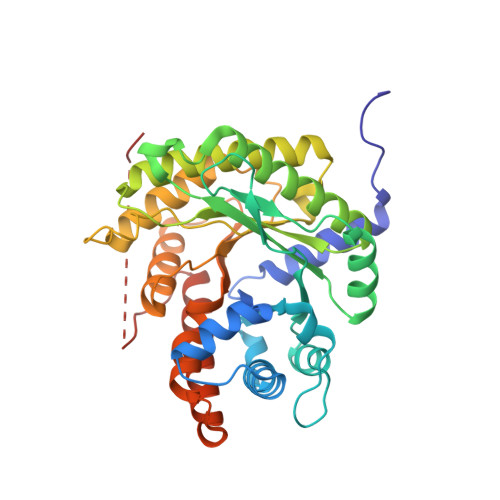Isomer activation controls stereospecificity of class I fructose-1,6-bisphosphate aldolases.
Heron, P.W., Sygusch, J.(2017) J Biol Chem 292: 19849-19860
- PubMed: 28972169
- DOI: https://doi.org/10.1074/jbc.M117.811034
- Primary Citation of Related Structures:
5TJS, 5TK3, 5TKC, 5TKL, 5TKN, 5TKP - PubMed Abstract:
Fructose-1,6-bisphosphate (FBP) aldolase, a glycolytic enzyme, catalyzes the reversible and stereospecific aldol addition of dihydroxyacetone phosphate (DHAP) and d-glyceraldehyde 3-phosphate (d-G3P) by an unresolved mechanism. To afford insight into the molecular determinants of FBP aldolase stereospecificity during aldol addition, a key ternary complex formed by DHAP and d-G3P, comprising 2% of the equilibrium population at physiological pH, was cryotrapped in the active site of Toxoplasma gondii aldolase crystals to high resolution. The growth of T. gondii aldolase crystals in acidic conditions enabled trapping of the ternary complex as a dominant population. The obligate 3( S )-4( R ) stereochemistry at the nascent C3-C4 bond of FBP requires a si -face attack by the covalent DHAP nucleophile on the d-G3P aldehyde si -face in the active site. The cis -isomer of the d-G3P aldehyde, representing the dominant population trapped in the ternary complex, would lead to re -face attack on the aldehyde and yield tagatose 1,6-bisphosphate, a competitive inhibitor of the enzyme. We propose that unhindered rotational isomerization by the d-G3P aldehyde moiety in the ternary complex generates the active trans -isomer competent for carbonyl bond activation by active-site residues, thereby enabling si -face attack by the DHAP enamine. C-C bond formation by the cis -isomer is suppressed by hydrogen bonding of the cis -aldehyde carbonyl with the DHAP enamine phosphate dianion through a tetrahedrally coordinated water molecule. The active site geometry further suppresses C-C bond formation with the l-G3P enantiomer of d-G3P. Understanding C-C formation is of fundamental importance in biological reactions and has considerable relevance to biosynthetic reactions in organic chemistry.
Organizational Affiliation:
From the Department of Biochemistry and Molecular Medicine, Université de Montréal, Montréal, Québec H3C 3J7, Canada.

















